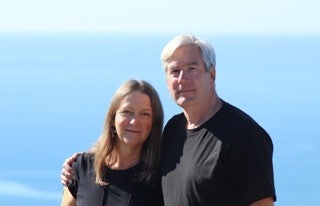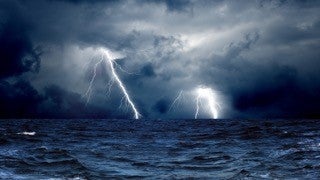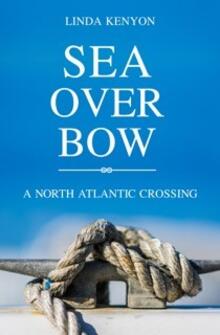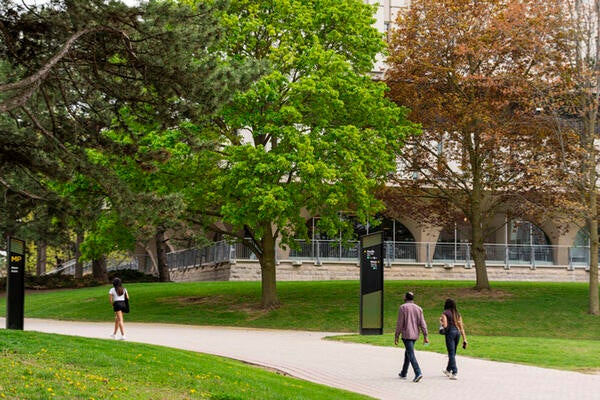
It's a big ocean
The middle of the North Atlantic is not one of the places Linda Kenyon (MA '87) ever expected to be.

The middle of the North Atlantic is not one of the places Linda Kenyon (MA '87) ever expected to be.
By Linda Kenyon (MA '87) AlumnusAfter completing a master’s degree in English at UWaterloo, I embarked on a long and satisfying career as a communications professional, first running my own business, then joining the Communications and Public Affairs team at UWaterloo. I was working as editor of the University of Waterloo Magazine when I met Chris Hatton (BASc ’76) who had always dreamed of sailing across the ocean in his 43-foot steel sailboat. Before long, I had decided to quit my job, sell everything I owned, and sail away with him. What’s the worst that could happen, I asked myself?

I found out soon enough.
We set out to sea from the southeastern tip of Antigua, planning to sail to the Azores, a distance of roughly 2,300 miles. We would be at sea for at least three weeks. The sailing was easy at first, then just as we were finishing our dinner on the fifth day, a band of dark clouds appeared on the horizon. In no time, big drops of rain started splattering on the windscreen, and in the distance, we could see lightning. Not the pretty kind that dances around the tops of clouds. Big, angry bolts of lightning stabbing the water. And they were coming closer.
I stationed myself in the companion-way where I was safely (I hoped) surrounded by wood. The first squall passed over us without incident, and the second. I was just starting to relax when Chris, who had been studying the radar, said, “There’s good news and bad news. The good news is I can see the other side of the next squall and it looks like it’s the last one. The bad news is it’s four miles wide.”

We didn’t get struck by lightning, but the further into the ocean we sailed, the rougher the sailing became. Our sturdy steel boat could take it, Chris could take it, but I had to dig deep to find the courage to keep going. What choice did I have?
 Chris’s engineering background served him well on the crossing—he dealt with the many calamities calmly and competently—but so did my degree in English literature. You have a lot of time to read out there (on the calm days) and I happily worked my way through the novels of Jane Austen, which I had learned to love as a grad student. I also wrote great letters home, which were circulated widely among friends and family, who eagerly awaited the next instalment. These letters formed the basis for my new book, Sea Over Bow: A North Atlantic Crossing, published by Signature Editions.
Chris’s engineering background served him well on the crossing—he dealt with the many calamities calmly and competently—but so did my degree in English literature. You have a lot of time to read out there (on the calm days) and I happily worked my way through the novels of Jane Austen, which I had learned to love as a grad student. I also wrote great letters home, which were circulated widely among friends and family, who eagerly awaited the next instalment. These letters formed the basis for my new book, Sea Over Bow: A North Atlantic Crossing, published by Signature Editions.
Chris and I are still sailing—we’re in the Bahamas right now, but we’re contemplating another ocean crossing, perhaps next year. Though after re-reading the book, I’m feeling a little less enthusiastic about it than I was. We’ll see.
You can follow Chis and Linda on their adventures here.

Read more
Shop Canadian this holiday season with festive porch plants, fashion-forward apparel, craft spirits and more from Waterloo entrepreneurs

Read more
For more than four decades, Waterloo professor Larry Smith has helped build the University's reputation for innovation and entrepreneurial excellence

Read more
Alumni volunteers play a vital role in Waterloo’s admissions process, helping shape the newest incoming class of university talent
The University of Waterloo acknowledges that much of our work takes place on the traditional territory of the Neutral, Anishinaabeg, and Haudenosaunee peoples. Our main campus is situated on the Haldimand Tract, the land granted to the Six Nations that includes six miles on each side of the Grand River. Our active work toward reconciliation takes place across our campuses through research, learning, teaching, and community building, and is co-ordinated within the Office of Indigenous Relations.